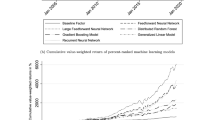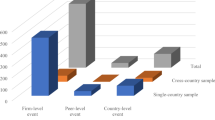Abstract
In this paper, we examine the dynamic relationship between actual stock returns, forecasted returns and investor risk aversion, where variables are analyzed in first difference form rather than levels. The idea behind using such methodology is to find out how variables move together contemporaneously, and to explain how changes in actual stock returns adjust to contemporary forecasted returns and changes in risk aversion, considering the interplaying effect of the Covid-19 pandemic. We use daily US stock market data, for five consecutive years ranging from 2018 to 2022. Empirical analysis shows that, ceteris paribus, (i) actual returns adjust swiftly to forecasted returns and (ii) the adjustment coefficient increases significantly during the pandemic, implying that investors become more sensitive to the implicit information in the formulated forecasts. In addition, it has been found that an increase in daily risk aversion leads to a simultaneous decline in actual stock returns. Although the risk aversion index reached high levels during the pandemic, its marginal effect on the dynamics of returns has diminished during this period, suggesting that investors with high levels of risk aversion become less sensitive to the ongoing crisis. Other factors, such as market volatility and trade intensity, have almost negligible effects on the dynamics of daily returns.
Similar content being viewed by others
Notes
Note that our estimates remain qualitatively stable as we use alternative models of forecasting such general AR or VAR models.
All variables of the regression equations are in difference form, so no lagged variables were included. Thus, h-Durbin is irrelevant to use.
This conclusion became more obvious if we re-estimate the first regression equation by including a quadratic term of the daily changes of the risk aversion index into the equation to get:
\(\Delta R_{t} = 0.000 + 0.85[F_{t - 1} \left( {R_{t} } \right) - R_{t - 1} ] - 0.004\Delta UNC_{t} + .000078\Delta UNC_{t}^{2}\)
R2 = 0.753. All the estimated parameters except the constant term are statistically significant at the 1% level.
This clearly shows that the sensitivity of ΔR, although negative, is getting slightly higher as the coefficient of the quadratic term indicates.
References
Ashour S, Hao G, Harpe A (2023) Investor sentiment, style investing, and momentum. J Financ Mark 62:100755
Baker M, Wurgler J (2006) Investor sentiment and the cross-section of stock returns. J Financ 61(4):1645–1680
Baker M, Wurgler J (2007) Investor sentiment in the stock market. J Econ Perspect 21(2):129–151
Bekaert G, Engstrom EC, Xu NR (2021) The time variation in risk appetite and uncertainty. Manage Sci 68(6):3975–4004
Bielstein P, Hanauer MX (2019) Mean-variance optimization using forward-looking return estimates. Rev Quant Financ Acc 52(3):815–840
Bouteska A (2020) Understanding the impact of investor sentiment on the price formation process: a review of the conduct of American stock markets. J Econ Asymm 22:e00172
Brahma S, Boateng A, Ahmad S (2023). Board overconfidence and M&A performance: evidence from the UK. Rev Quant Finance Account, pp 1–29
Brennan MJ, Wang AW (2010) The mispricing return premium. Rev Financ Stud 23(9):3437–3468
Chen W (2021) Equity investor sentiment and bond market reaction: test of overinvestment and capital flow hypotheses. J Financ Mark 55:3–20
Chen CR, Lung PP, Wang FA (2013) Where are the sources of stock market mispricing and excess volatility? Rev Quant Financ Acc 41:631–650
Chundakkadan R, Nedumparambil E (2022) In search of COVID-19 and stock market behavior. Glob Financ J 54:100639
De Long JB, Shleifer A, Summers LH, Waldmann RJ (1990) Noise trader risk in financial markets. J Polit Econ 98(4):703–738
Ferrer M, Ulrich K, González-Tejero C (2023) Investors’ confidence in the crowdlending platform and the impact of Covid-19. J Bus Res 155:113433
Frydman C, Wang B (2020) The impact of salience on investor behavior: evidence from a natural experiment. J Financ 75(1):229–276
Frydman R, Mangee N, Stillwagon J (2021) How market sentiment drives forecasts of stock returns. J Behav Financ 22(4):351–367
Fu J, Zhou Q, Liu Y, Wu X (2020) Predicting stock market crises using daily stock market valuation and investor sentiment indicators. N Am J Econ Finance 51:100905
Hsu YL, Tang L (2022) Effects of investor sentiment and country governance on unexpected conditional volatility during the COVID-19 pandemic: evidence from global stock markets. Int Rev Financ Anal 82:102186
Hu S, Zhong M, Cai Y (2019) Impact of investor behavior and stock market liquidity: evidence from China. Entropy 21(11):1111
Huber C, Huber J, Kirchler M (2021) Market shocks and professionals’ investment behaviour: evidence from the COVID-19 crash. J Bank Finance 133:106247
Hurwitz H (2018) Investor sentiment and management earnings forecast bias. J Bus Financ Acc 45(1–2):166–183
Huynh TLD, Foglia M, Nasir MA, Angelini E (2021) Feverish sentiment and global equity markets during the COVID-19 pandemic. J Econ Behav Organ 188:1088–1108
Jankensgård H, Vilhelmsson A (2018) The shareholder base hypothesis of stock return volatility: empirical evidence. Financ Manage 47(1):55–79
Jiang F, Lee J, Martin X, Zhou G (2019) Manager sentiment and stock returns. J Financ Econ 132(1):126–149
Jiang B, Zhu H, Zhang J, Yan C, Shen R (2021) Investor sentiment and stock returns during the COVID-19 pandemic. Front Psychol vol 12
Jirasakuldech B, Dudney DM, Zorn TS, Geppert JM (2011) Financial disclosure, investor protection and stock market behavior: an international comparison. Rev Quant Financ Acc 37(2):181–205
Jones CM, Kaul G, Lipson ML (1994) Transactions, volume, and volatility. Rev Financ Stud 7(4):631–651
Karpoff JM (1987) The relation between price changes and trading volume: a survey. J Financ Quant Anal 22(1):109–126
Kostopoulos D, Meyer S, Uhr C (2022) Ambiguity about volatility and investor behavior. J Financ Econ 145(1):277–296
Liang C, Hong Y, Huynh L, Duc T (2023) Asymmetric dynamic risk transmission between financial stress and monetary policy uncertainty: thinking in the post-covid-19 world. Rev Quant Financ Acc 60(4):1543–1567
Lim B, Zohren S (2021) Time-series forecasting with deep learning: a survey. Phil Trans R Soc A 379(2194):20200209
Mbanga C, Darrat AF, Park JC (2019) Investor sentiment and aggregate stock returns: the role of investor attention. Rev Quant Financ Acc 53(2):397–428
McTier BC, Tse Y, Wald JK (2013) Do stock markets catch the flu? J Financ Quant Anal 48(3):979–1000
Pástor Ľ, Sinha M, Swaminathan B (2008) Estimating the intertemporal risk-return tradeoff using the implied cost of capital. J Financ 63(6):2859–2897
Rapach D, Zhou G (2013) Forecasting stock returns. In Handbook of economic forecasting vol 2, pp 328–383. Elsevier
Shaikh I (2021) Impact of COVID-19 pandemic disease outbreak on the global equity markets. Econ Res -Ekonomska Istraživanja 34(1):2317–2336
Shiller RJ (2014) Speculative asset prices. Am Econ Rev 104(6):1486–1517
Smales LA (2016) Trading behavior in S&P 500 index futures. Rev Finan Econ 28:46–55
Tessler N, Venezia I (2022) A multicountry measure of comovement and contagion in international markets: definition and applications. Rev Quant Financ Acc 58(4):1307–1330
Wooldridge JM (2018) Introductory econometrics: a modern approach, 7th edn. Cengage, Boston
Wu JL, Huang MT, Yang CS, Liu KH (2021) Sentiment analysis of stock markets using a novel dimensional valence–arousal approach. Soft Comput 25(6):4433–4450
Zhang D, Hu M, Ji Q (2020) Financial markets under the global pandemic of COVID-19. Financ Res Lett 36:101528
Zhang Q, Choudhry T, Kuo JM, Liu X (2021) Does liquidity drive stock market returns? The role of investor risk aversion. Rev Quant Financ Acc 57(3):929–958
Acknowledgements
This research was partly supported by grants IRG C20116 and C20117. This support is gratefully acknowledged. We also thank the editor and the anonymous referees who have provided valuable comments on an earlier version of this paper.
Author information
Authors and Affiliations
Corresponding author
Additional information
Publisher's Note
Springer Nature remains neutral with regard to jurisdictional claims in published maps and institutional affiliations.
Rights and permissions
Springer Nature or its licensor (e.g. a society or other partner) holds exclusive rights to this article under a publishing agreement with the author(s) or other rightsholder(s); author self-archiving of the accepted manuscript version of this article is solely governed by the terms of such publishing agreement and applicable law.
About this article
Cite this article
Abo Al Haija, A., Lahyani, R. Dynamic interactions of actual stock returns with forecasted stock returns and investors’ risk aversion: empirical evidence interplaying the impact of Covid-19 pandemic. Rev Quant Finan Acc 61, 1129–1149 (2023). https://doi.org/10.1007/s11156-023-01181-0
Accepted:
Published:
Issue Date:
DOI: https://doi.org/10.1007/s11156-023-01181-0




